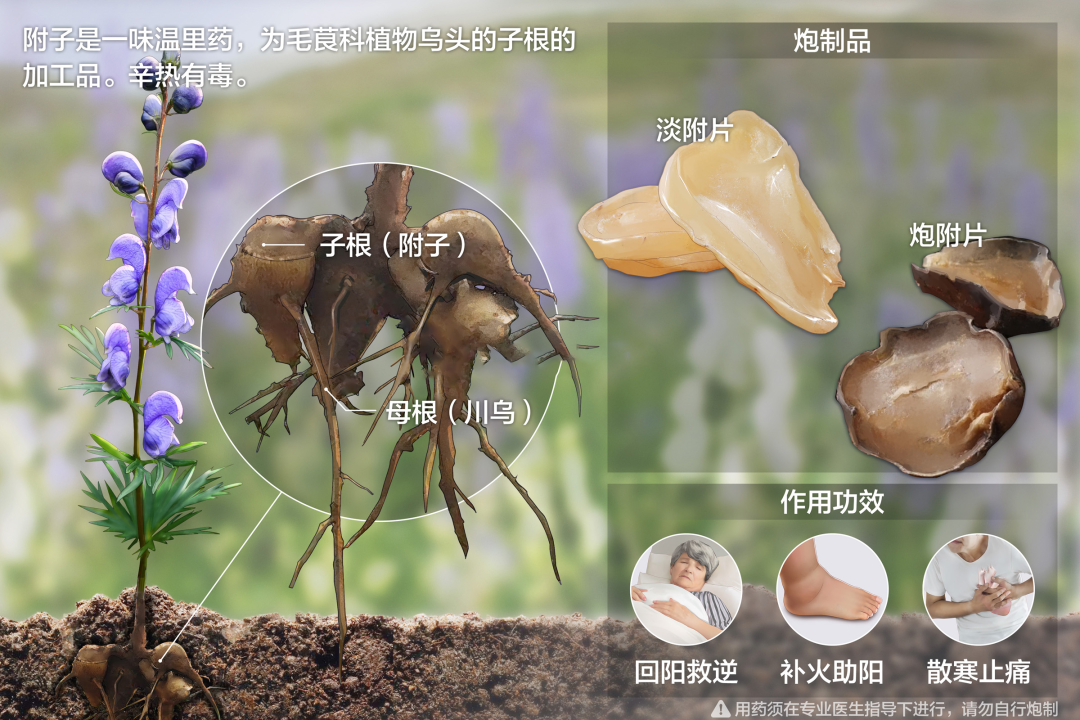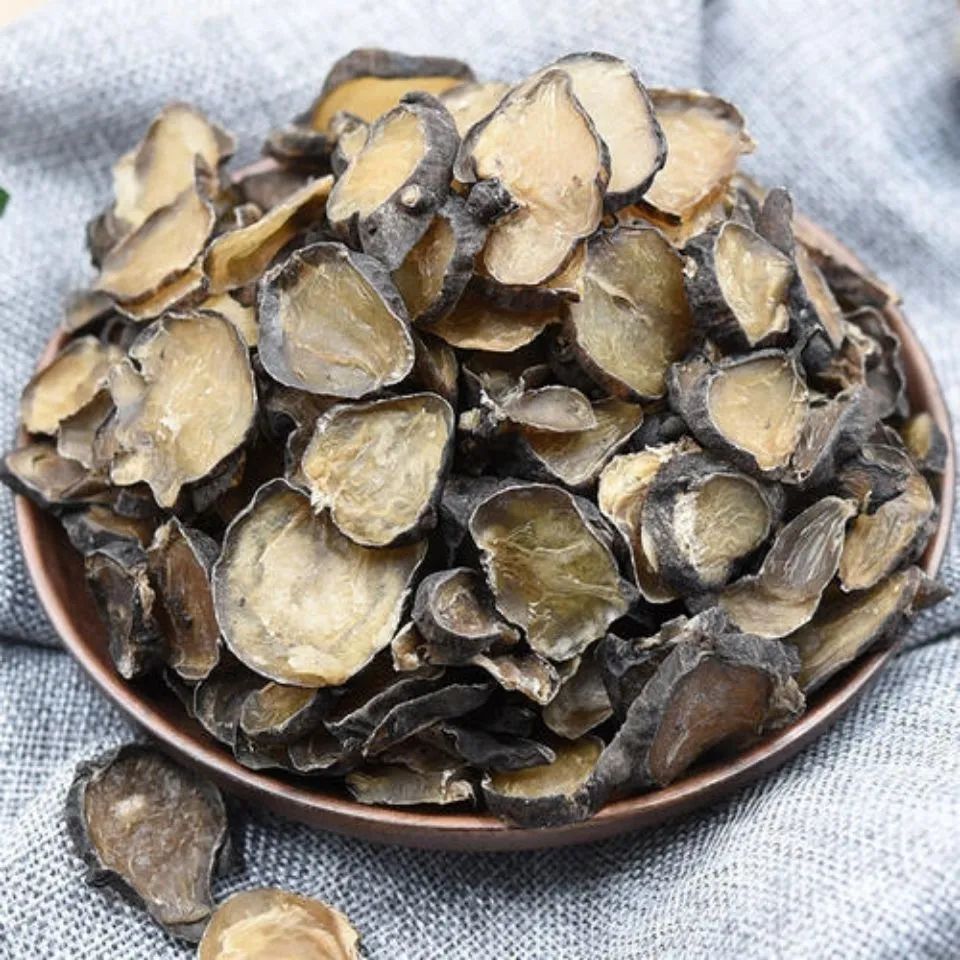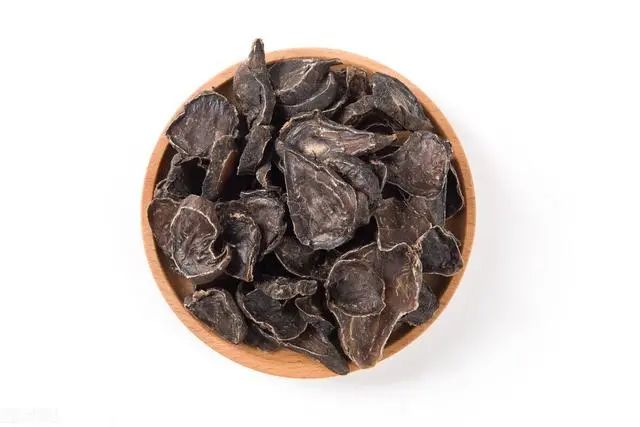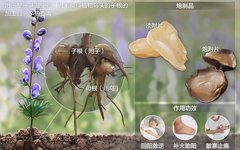Alias: Fuzi slices, Black Fuzi slices, Light Fuzi slices, White Fuzi slices, Processed Fuzi slices
Overview: The Chinese medicinal material Fuzi is a warming herb, processed from the tuberous roots of the Aconitum plant (Wutou).
Main Effects: Revives Yang, rescues from reversal, supports fire and assists Yang, disperses cold and alleviates pain.

Typical Characteristics
Fuzi is pungent and sweet, with a very hot nature; it is toxic. It enters the Heart, Kidney, and Spleen meridians. Fuzi is purely Yang and hot, with strong toxicity, entering the Heart, Kidney, and Spleen meridians. It assists Heart Yang from above, warms Spleen Yang from the middle, and strengthens Kidney Yang from below, making it a key herb for reviving Yang, supporting fire, and rescuing from reversal, commonly used for Yang collapse and Yang deficiency syndromes. Additionally, its pungent and hot nature disperses, making it a powerful herb for dispelling Yin cold, eliminating wind-dampness, and alleviating pain, often used for cold-damp pain. This herb has the effects of reviving Yang, supporting fire, and dispersing cold to alleviate pain.
Main Production Area
Primarily produced in Sichuan.
Parts Used:
This herb is processed from the tuberous roots of the Aconitum plant.
Characteristics of the Parts Used:
Salted Fuzi is conical, 4-7 cm long, and 3-5 cm in diameter. The surface is gray-black, covered with salt frost, with a depressed bud scar at the top and surrounding tuberous root protrusions or scars. It is heavy, with a cross-section that is gray-brown, showing small voids filled with salt frost and polygonal growth rings, with irregularly arranged vascular bundles on the inner side of the rings.
The aroma is faint, with a salty and numbing taste that prickles the tongue. Black Fuzi slices are longitudinally cut, wider at the top and narrower at the bottom, measuring 1.7-5 cm long, 0.9-3 cm wide, and 0.2-0.5 cm thick. The outer skin is black-brown, with a dark yellow cut surface that is oily and glossy, semi-transparent, and has longitudinal vascular bundles. The texture is hard and brittle, with a horn-like fracture. The aroma is faint, and the taste is mild. White Fuzi slices have no outer skin, are yellow-white, semi-transparent, and about 0.3 cm thick.
Literature Records
“Shennong’s Herbal Classic”: “Mainly for wind-cold cough, warming the middle, treating traumatic injuries, breaking up masses, blood stasis, cold-dampness causing pain, and knee pain with inability to walk.”
“Bencao Bie Lu”: “For cold and weak feet, lumbar and spine wind-cold, cold pain in the heart and abdomen, cholera with cramps, dysentery with red and white, and strengthening the sinews and bones.”
“Bencao Beiyao”: “Greatly dries and revives Yang, supplements Kidney fire, and expels wind-cold dampness.”
Functions and Efficacy
Fuzi has the effects of reviving Yang, supporting fire, and dispersing cold to alleviate pain.
Indications
Fuzi is used for Yang collapse, cold limbs, weak pulse, insufficient Heart Yang, chest obstruction and heart pain, cold and deficient vomiting and diarrhea, cold pain in the abdomen, Kidney Yang deficiency, impotence, cold water retention, Yang deficiency with external pathogens, and cold-damp obstruction pain.
Yang Collapse Syndrome
Used for Yang collapse with cold limbs and weak pulse, often combined with Ganjiang (Dried Ginger) for synergistic effect.
For Yang collapse with Qi deficiency, often paired with Ren Shen (Ginseng) to revive Yang and tonify Qi.
Yang Deficiency Syndromes
Used for Kidney Yang deficiency with cold pain in the waist and knees, impotence, often combined with Rougui (Cinnamon), Duzhong (Eucommia), and Lu Jiao Jiao (Deer Antler Glue).
For Spleen Yang deficiency with cold vomiting and diarrhea, and cold pain in the abdomen, often combined with Dangshen (Codonopsis), Ganjiang (Dried Ginger), and Baizhu (Atractylodes).
For Spleen and Kidney Yang deficiency with cold water retention and difficulty urinating, often combined with Baizhu (Atractylodes) and Fuling (Poria).
For Yang deficiency with external wind-cold, often combined with Mahuang (Ephedra) and Xixin (Asarum).
Cold Congealing Pain
Most suitable for treating severe cold obstruction pain, often combined with Guizhi (Cinnamon Twig), Gancao (Licorice), and Baizhu (Atractylodes).
For abdominal pain due to cold congealing and Qi stagnation, often combined with Muxiang (Aucklandia) and Yanhusuo (Corydalis).
Note: The use of Chinese medicinal materials must be based on syndrome differentiation and treatment, and should be used under the guidance of a qualified TCM practitioner. Self-medication or reliance on folk remedies and advertisements is not advisable.
Modern Research
This herb has various pharmacological effects including cardiotonic, vasodilatory, analgesic, anti-inflammatory, anti-ulcer, anti-tumor, immune-enhancing, anti-hypoxia, and anti-cold properties.
Usage Method
Fuzi is used for reviving Yang, supporting fire, and dispersing cold to alleviate pain. It is generally used in decoction form.

Processing Methods
Processed Fuzi Slices
Take clean river sand, place it in a frying container, heat with strong fire until flexible, add clean Fuzi slices, and stir-fry continuously until they puff up and slightly change color. Remove, sift out the sand, and cool.
Light Fuzi Slices
Take clean salted Fuzi, soak in clean water, changing the water 2-3 times daily until the salt is completely removed. Boil with Gancao (Licorice) and black beans until thoroughly cooked, then taste to ensure no numbing sensation on the tongue before removing, discarding Gancao and black beans, slicing thinly, and drying. Sift out fragments. For every 100 kg of salted Fuzi, use 5 kg of Gancao and 10 kg of black beans.
Precautions
Should not be used with Banxia (Pinellia), Gualou (Trichosanthes), Gualou Pi (Trichosanthes Peel), Gualouzi (Trichosanthes Seed), Tianhuafen (Trichosanthes Root), Chuanbeimu (Fritillaria), Zhebeimu (Fritillaria), Pingbeimu (Fritillaria), Yibeimu (Fritillaria), Hubeibeimu (Fritillaria), Bailian (Bletilla), and Bai Ji (Bletilla). Pregnant women should avoid use, and it is contraindicated for those with Yin deficiency and Yang excess.
Salted Fuzi has a faint aroma, salty and numbing taste that prickles the tongue; the best quality is large, heavy, gray-black, and has a surface covered with salt frost. Black Fuzi slices (Black Fuzi) have a faint aroma and mild taste; the best quality has a black-brown skin and an oily, glossy cut surface. White Fuzi slices have a faint aroma and mild taste; the best quality is large, yellow-white, oily, and semi-transparent.
Raw products are for external use; internal use requires processing. Overconsumption or improper processing and decoction methods can lead to toxicity.
Medication Tips
Q What are the effects and functions of Mahuang Fuzi Xixin Decoction?
A: Mahuang Fuzi Xixin Decoction consists of Mahuang (Ephedra, without nodes), Xixin (Asarum), and Fuzi (processed, peeled, broken into eight pieces). It has the effect of assisting Yang and releasing the exterior. It is indicated for those with a constitution of Yang deficiency, external wind-cold, no sweating, aversion to cold, fever, curled up posture, white tongue coating, and a submerged pulse.
Q
What is the difference between Lizhong Wan and Fuzi Lizhong Wan?
A:The composition of the herbs is different: Fuzi Lizhong Wan is made by adding a strongly warming herb, Fuzi, to the base of Lizhong Wan. Each has its strengths: Fuzi Lizhong Wan not only warms the middle and disperses cold but does so more effectively than Lizhong Wan, and also has the effect of warming the Kidney and assisting the Spleen. It can treat severe cases of Spleen and Stomach Yang deficiency, as well as Spleen and Kidney Yang deficiency; while Lizhong Wan is used for treating middle Jiao Yang deficiency, with symptoms of diarrhea without thirst, vomiting and abdominal pain, cold cholera, Yang deficiency with blood loss, chest obstruction due to deficiency, and post-illness preference for spitting. Fuzi Lizhong Wan is used for Spleen and Stomach Yang deficiency, cold pain in the abdomen, vomiting and diarrhea, and cold hands and feet.
Q
What are the effects and functions of White Fuzi?
A: White Fuzi is the tuber of the plant of the family Araceae, known as Du Jiao Lian. It is pungent and sweet, with a warm nature; it enters the Stomach and Liver meridians. It has the effects of dispelling wind-phlegm, unblocking meridians, and detoxifying to relieve pain. It is indicated for wind-stroke with phlegm obstruction, facial asymmetry, migraine, tetanus, snake bites, scrofula, and abscesses.
References
[1] National Pharmacopoeia Commission. Pharmacopoeia of the People’s Republic of China (Part 1) [M]. Beijing: China Medical Science Press, 2020.
[2] Wang Jian, Zhang Bing. Clinical Chinese Medicine (2nd Edition) [M]. Beijing: People’s Health Publishing House, 2016.
[3] Zhou Zhenxiang, Tang Decai. Clinical Chinese Medicine (10th Edition) [M]. Beijing: China Traditional Chinese Medicine Press, 2016.
[4] Zhong Gansheng. Chinese Medicine (4th Edition) [M]. Beijing: China Traditional Chinese Medicine Press, 2016.
[5] Yan Zhenghua. Chinese Medicine (2nd Edition) [M]. Beijing: People’s Health Publishing House, 2006.
[6] Xie Ming. Formulary (3rd Edition) [M]. Beijing: People’s Health Publishing House, 2016.
[7] Tan Xinggui. Chinese Medicinal Cuisine [M]. Beijing: China Traditional Chinese Medicine Press, 2003.
Beijing Zhou’s Shizhen Hall Pharmaceutical Co., Ltd. was established in June 2008, integrating Chinese medicinal material cultivation, Chinese medicinal slice production, research and development, sales, and TCM medical specialty services.
Beijing Dongbitang Traditional Chinese Medicine Museum is dedicated to inheriting and promoting TCM culture, carefully creating a comprehensive display of ancient TCM texts, prescription manuscripts, tools, plaques, rare medicinal materials, medicinal specimens, and recreating TCM diagnostic and treatment scenes, showcasing the characteristics of TCM culture from different periods.

